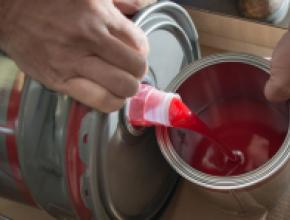Woodworkers are known to be skilled at working with their hands, but they are also adept at managing dangerous equipment and working in high-risk environments. Knives, hand saws, electric saws, hammers and a variety of blades are often seen in woodworking shops and manufacturing facilities of all sizes. But these dangers aren’t the only risks that should caution woodworkers and facility owners. Less obvious risks also lurk in woodshops and manufacturing facilities.
In this article, we will focus on the top dangers threatening woodshop facilities every day—the general liability and property exposures. Whether the business focuses on custom woodworking, closets, millwork, furniture manufacturing or any other line of the business, these uncontrolled exposures could bring the entire business literally to the ground.
1. Wood Dust
Wood dust is a nearly invisible threat and the top hazard to woodworking facilities. When exposed to an ignition source, tiny, highly-combustible wood particles can serve as the eager fuel for fires and explosions. Wood dust is particularly dangerous when it is allowed to build up the way it tends to, in cracks, crevices and corners. Wood dust fires and explosions are often started by open flames, uncontrolled smoking, impact sparks, hot work (grinding, welding, torching) or out-of-date, faulty, or poorly maintained electrical equipment.
To protect woodworking or manufacturing facilities from wood-dust related fires, good housekeeping is key. Facility owners and operators should ensure that wood dust is not building up and that electrical equipment is protected or moved from any potential buildup areas. Dust buildup any thicker than a dime creates an exposure.
Additionally, facilities should have dust control equipment in place. Specifically, they should use a dust control system with its own safety shut-off and alarm system. For example, dust control systems use a tube to suck the dust into the dust control system. Inside a properly engineered system, a light will illuminate if it detects a spark caused by a piece of metal or nail entering the tube. When this bulb is triggered, the dust collection system will spray a mist. When, the spark passes through, it will be soaked. It is basically a sprinkler system within a dust collection system.
In addition to these dust collection systems and proper housekeeping, managers, owners and operators should service and maintain all equipment regularly. Ventilation systems and ducts should also be checked often to ensure no blockage is present. At the same time, daily cleanings should include floors, walls, ledges and ceilings to reduce sawdust buildup.
2. Oily Rags
Oil-soaked rags have a habit of piling up in any woodshop, from residential home garages to commercial woodworking shops to major manufacturers. Though a simple tool, rags are handy for applying stains and finishes—but those chemicals turn the rags into potent, highly flammable fuel for fires. If an oily rag is then thrown in a corner or into the trash, it could spontaneously combust into fire.
Spontaneous combustion and chemical reactions are a major cause of fires in the U.S., according to the National Fire Protection Association. Spontaneous combustion occurs when an object increases in temperature without pulling in heat from its immediate area. The group found that between 2005 and 2009, spontaneous combustion or chemical reactions were responsible for 14,070 fires. Of these, 5,250 were outside non-rubbish fires and 4,460 were outside rubbish-related fires.
Those rags should be stored in a UL-certified or FM-approved metal can that has a self-closing top on it so if they do combust inside, the fire can’t escape. Woodshops should have oily waste cans.
3. Storage of Flammables
In woodworking shops, solvents, lacquers and thinners are nearly as common as wood dust. Most people know to avoid open flames when using these products, but they can also prove to be dangerous while simply sitting on the shelf. Without proper storage, they can be exposed to an ignition source or spontaneously combust—fueling fatal fires.
To mitigate this risk, these items should be stored in UL-certified or FM-approved cabinets that are properly grounded. These cabinets have a fire rating, so their doors are durable and fire resistant. Consequently, if a fire ignites in the cabinet, the cabinet can contain the fire. These cabinets are grounded to a piece of metal as an additional safety measure, so static electricity doesn’t build up inside and serve as an ignition source for solvents, thinners and lacquers.
Woodshops are also required to follow laws related to the proper disposal of this hazardous waste and report emissions according to state guidelines.
4. Glue
Like solvents, lacquers and thinners, solvent-based glue (commonly referred to as red glue) can also be very dangerous within a woodshop or manufacturing facility. Red glues emit vapors that are highly flammable and could impair or sicken those who breathe in the vapors.
Woodshop workers use a considerable amount of glue, particularly red glue, which most workers favor because it really sticks. It is so strong, it is often used to secure laminate countertops. The vapors, which are heavier than air, sink to the floor where they accumulate and can easily find an ignition source, like a hot water heater, electrical outlet or furnace with an open flame and cause an explosion.
To mitigate this exposure, woodworkers should use water-based glues (commonly referred to as yellow glue) over red glue where possible and they should not use red glue while in a confined space but in an approved booth protected by a fire suppression or automatic sprinkler system. An exhaust fan should also be used to pull the dangerous vapors from the room. Even in storage, red glue poses a risk to the facility, so large drums of glue should be stored outside the building in an approved flammable liquids storage room as per the NFPA 30 Flammable and Combustible Liquids Code.
Keep It Tidy
In the end, the best way to reduce these risks to a woodshop is to be attentive and neat. Keep up with housekeeping and perform quality control checks to make sure the space is properly cleaned and maintained.
Regular facility checks are also critical to make sure flammable items are not left to pile up, and to make sure that chemicals and solvents are being closed and stored properly at the end of each work day.
The risks to these facilities are real, but with proper checks in place, woodshops and larger woodworking facilities can be sure they are doing their best to keep their facilities safe for their employees and protected from an extensive fire that could prove costly or terminal for their business.
About the author: Chris Crucitt is a 40-year veteran in commercial insurance including, administration, sales, and underwriting. Chris served for ten years as vice president of underwriting at Pennsylvania Lumbermens Mutual Insurance Co. and is now the company’s vice president of marketing. For information, visit plmins.com; Twitter: @PLMinsurance.






Have something to say? Share your thoughts with us in the comments below.